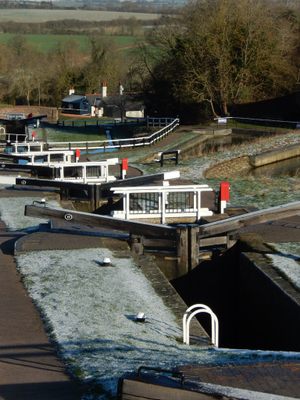About
A lock ladder or staircase is used to raise canal boats over large vertical distances within a small horizontal range. They operate by allowing the lower gate of one lock to form the upper gate of the adjacent lock.
To avoid wasting water, they require very careful management. Passage through such lock systems often involves a significant delay. This set of locks at Foxton in Leicestershire is the highest combination of ladders of locks in the United Kingdom. It's located on the Leicester Line of the Grand Union Canal.
When this flight of ten locks was constructed in 1814, it was intended for the passage of small boats. This was done to allow quicker changes in the levels and to allow 14-foot beam boats safe passage. An inclined plane boat lift was constructed in 1900.
The intended installation of a similar lift at the lock flight at Watford, just over the county border in Northamptonshire, never took place. Thus, broad beam boats could never use that part of the canal. The boat lift, which dragged boats in large caissons up the inclined plane balanced by the weight of descending boats, was found to be uneconomical.
In 1910, the boat lift was closed and the lock flight was refurbished. The boat lift was dismantled for scraps during the 1920s. The remains of the inclined plane are clearly visible today. There is hope this iconic structure will be reopened as a tourist attraction.
The amazing lock ladder system, however, still operates and attracts canal enthusiasts from across the country. Together, the locks and inclined plane serve as a monument to both the ingenuity and ambition of British canal engineers.
Related Tags
Know Before You Go
Unlike the majority of locks on the British canal system, this flight of locks is manned by Canal and River Trust staff, who closely supervise users. This is essential to prevent wastage of water. The gates are padlocked overnight.
Published
January 13, 2021





































